Maneuvering the complex landscape of leave laws in the United States is far from easy. With a plethora of federal laws and regulations – plus state-level variations on top of that – it’s enough to make you go cross-eyed before you even start digging into the details.
To help you navigate the legal nuances a little better, we made this comprehensive overview of United States leave laws. From New Year’s Day to voting leave, it covers everything you need to know about paid holidays by law in your country.
So, let’s get right to it!
Public Holidays
What does this leave type mean?
Public holidays are nationally recognized observances that are established by government authorities and institutions to mark significant events or celebrations. Although not always designated as days off from work or school, they are intended to allow individuals to celebrate or commemorate important occasions with friends and family.
These are the officially recognized public holidays in the United States:
- New Year (January 1)
- Martin Luther King’s Birthday (Third Monday in January)
- Washington’s Birthday (Third Monday in February)
- Memorial Day (Last Monday in May)
- Juneteenth National Independence Day (June 19)
- Independence Day (July 4)
- Labor Day (First Monday in September)
- Columbus Day (Second Monday in October)
- Veterans Day (November 11)
- Thanksgiving (Fourth Thursday in November)
- Christmas (December 25)
Federal requirements
According to the U.S. federal law, employers are not required to provide paid time off for public holidays.
Nevertheless, if you decide to close your private business for any public holiday recognized by the federal government, you have to provide full pay to overtime-exempt employees, as long as they still work any portion of the workweek. You are not required to provide non-exempt employees with holiday pay in the private sector.
The situation is different for federal workers. They are legally entitled to all the 11 paid public holidays listed above.
State requirements
A few states, such as Massachusetts and Rhode Island, require private businesses to provide employees with paid days off on certain public holidays or with premium holiday pay in case they have to work.
The requirements differ from one industry and type of business to another. For example, according to Massachusetts Blue Laws, non-retail companies are not allowed to operate on such restricted holidays as Memorial Day and Labor Day, while retail businesses can operate during the restricted holidays if they have an official permit.
Real-life application
Even though not legally required to grant paid days off on public holidays to employees, many U.S. employers actually do so. According to recent PTO statistics, the most common paid holidays in the country include New Year, Memorial Day, Independence Day, Labor Day, Thanksgiving, and Christmas. Yet in some cases, these paid days off are used by employees as part of their annual accrued paid time off (PTO).
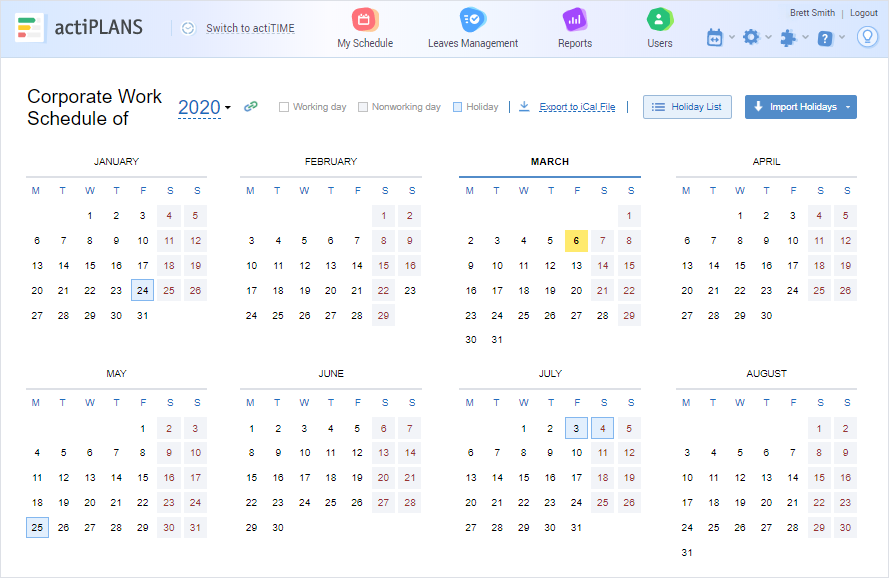
Create a custom work calendar for your team and track public holidays the easy way with actiPLANS
Vacation + Personal Days Off
What does this leave type mean?
Vacation leave, also known as annual leave or PTO, is a type of employee benefit that allows workers to take time off from work for leisure, rest, and personal reasons (sometimes while still receiving their regular pay). Typically, vacation leave and personal time off are earned by employees on a pro-rated basis, depending on how many hours or days they have worked, and can be accumulated over time for use at a later date.
Federal requirements
Under the Fair Labor Standards Act (FLSA), federal law does not require employers to provide employees with paid or unpaid vacation time.
State requirements
Currently, just a few states – including Maine and Nevada – have mandatory paid vacation leave laws. They require employers to provide their employees with a minimum amount of paid vacation time per year (i.e., at least 1 accrued leave hour per 40 work hours in Maine and at least 0.7692 leave hour per 40 work hours in Nevada).
Real-life application
In reality, paid vacation policies differ from one company to another, with some employers going as far as to provide employees with unlimited PTO. In the competitive landscape of today’s job market, doing so is probably the most effective way to entice top talent to join your team since generous PTO packages remain one of the most attractive employee benefits of all time.
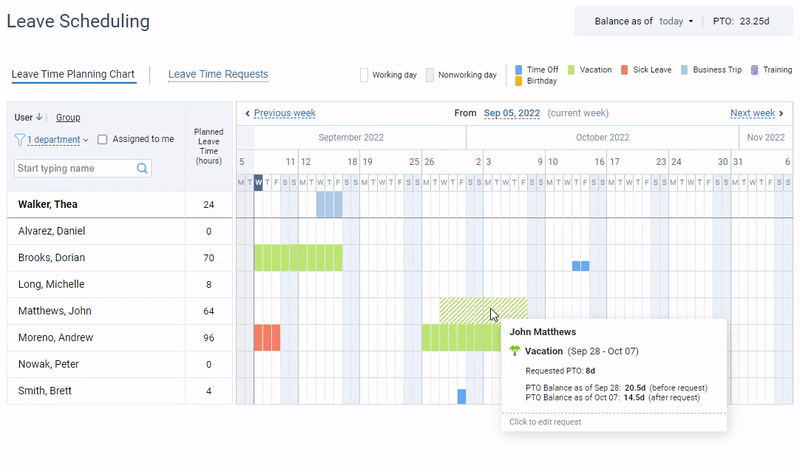
Use actiPLANS to request and approve any type of time off in just a few clicks
Sick Leave
What does this leave type mean?
Sick leave provides a stipulated amount of paid or unpaid time off to employees who cannot work due to an illness or injury. It serves as an essential workplace benefit since it promotes the welfare and well-being of employees, allowing them to recover from an ailment without fear of retribution or loss of income.
Federal requirements
The U.S. federal law governing sick leave falls under the Family and Medical Leave Act (FMLA) – a labor law that provides eligible employees up to 12 workweeks of unpaid leave in a 12-month period for certain medical and family reasons, including:
- Their own serious health condition,
- The birth or adoption of a child,
- The need to care for a spouse, child, or parent with a serious health condition.
State requirements
In addition to the FMLA, some states and cities have passed their own sick leave laws. For example, as of July 1, 2020, the state of California requires employers to provide employees with paid sick leave. The amount of paid sick leave hours an employee is entitled to depends on the size of the employer and the employee’s work schedule.
Similarly, the city of Seattle has passed a Paid Sick and Safe Time Ordinance, which requires employers to provide paid sick and safe time to employees working in Seattle in case of a medical condition or domestic assault.
Real-time application
According to the 2020 data by the Bureau of Labor Statistics, about 78% of civilian workers and 75% of private industry workers had access to paid sick leave. However, a large portion of low-wage workers and small business employees are quite often not even eligible for unpaid FMLA leave because employers have the right to exclude them from FMLA coverage if certain conditions are met (Source).
Luckily, the number of people-oriented companies is growing in the country, and as responsible employers, they will never make their staff member compromise their own health and the overall business performance by coming to work sick.
In addition to reduced team productivity, failing to provide your team with an adequate sick leave policy can result in a high absenteeism rate and decreased employee morale. Hence, it’s better to manage employee sickness absences wisely even if you’re not legally required to provide paid or unpaid sick leave.
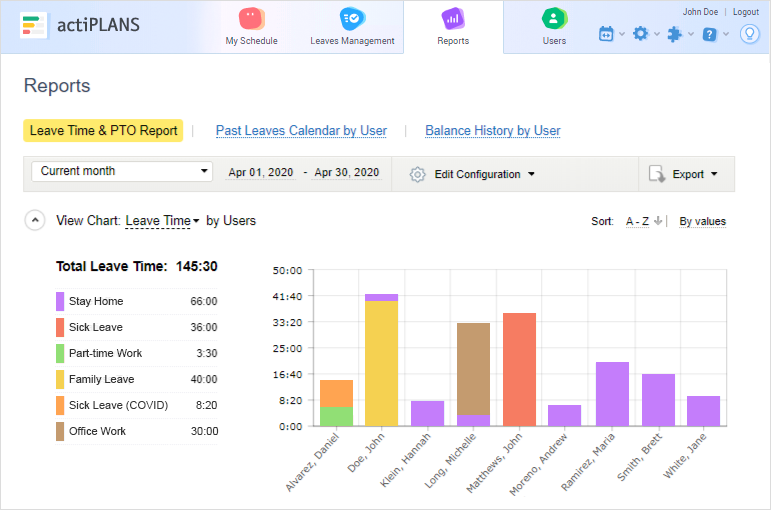
Analyze your sickness absence trends and other time off data in depth using actiPLANS reports
Maternity / Paternity Leave
What does this leave type mean?
The purpose of maternity and paternity leave (aka family leave) is to provide new parents with the necessary time to bond with their newborns, establish a supportive home environment, and recover from childbirth. Additionally, this leave provides parents with the opportunity to address any potential health concerns related to pregnancy and childbirth.
Federal requirements
The FMLA guarantees eligible employees up to 12 weeks of unpaid leave every 12 months for the birth of their child, adoption, or foster care placement. However, there are certain criteria that must be met in order for an employee to be eligible for this type of leave:
- The employee must have worked for the company for at least 12 months and have accumulated at least 1,250 hours of work during that time.
- The employer must have at least 50 employees within 20 work weeks of the current or previous year.
State requirements
California was the first state to enact a paid family leave program, which provides employees with partial wage replacement when they take time off for family caregiving or bonding with a new child. Some other states – including Connecticut, New York, and Colorado – have enacted similar laws, while many have yet to adopt any kind of paid family leave program.
Real-life application
In recent years, there has been a trend toward offering more generous maternity and paternity leave policies, particularly among larger companies. For example, such tech giants as Airbnb, Microsoft, and Google now offer 22-24 weeks of paid parental leave to their employees. But overall, the implementation of family leave varies greatly across different companies and industries.
For example, some businesses may have a formal maternity or paternity leave policy in place that outlines the amount of time off an employee can take, whether the leave is paid or unpaid, and any other relevant details. Other companies may have a less formal approach, where employees have the right to negotiate time off with their managers on a case-by-case basis.
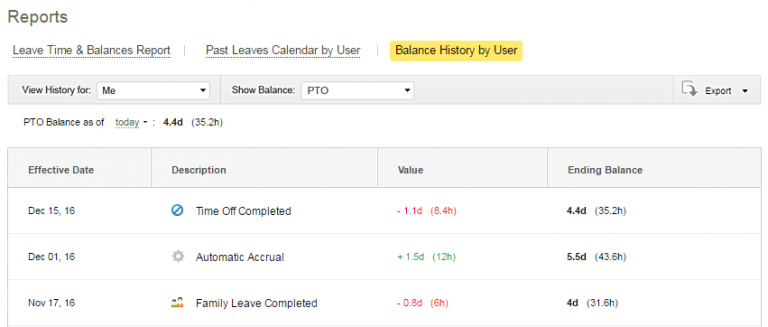
Use actiPLANS to keep tabs on employees’ time off balances and manage their leave requests without mistakes
Bereavement Leave
What does this leave type mean?
Bereavement leave, also known as compassionate leave or grievance leave, is granted to employees who have experienced the loss of a loved one. It gives them the time and space needed to grieve and cope with the death of a family member, spouse, or domestic partner.
Federal requirements
There is no federal law in the United States that mandates employers to grant employees paid or unpaid time off for bereavement purposes.
State requirements
California, Illinois, and Oregon have unpaid bereavement leave laws. The periods of time off employees are entitled to in these states range from five days to two weeks.
Real-life application
According to Fortune, 90% of employers offer paid bereavement leave to employees who have experienced the loss of their loved ones. However, in a vast majority of cases, employees are entitled to no more than up to three days off.
Overall, the amount of leave offered usually depends on the size of the company and its HR policies. Some employers may also require employees to provide documentation to confirm the death of a family member or show proof of the relationship. Ensuring compliance with such requirements helps the company to prevent the misuse of benefits by unscrupulous employees.
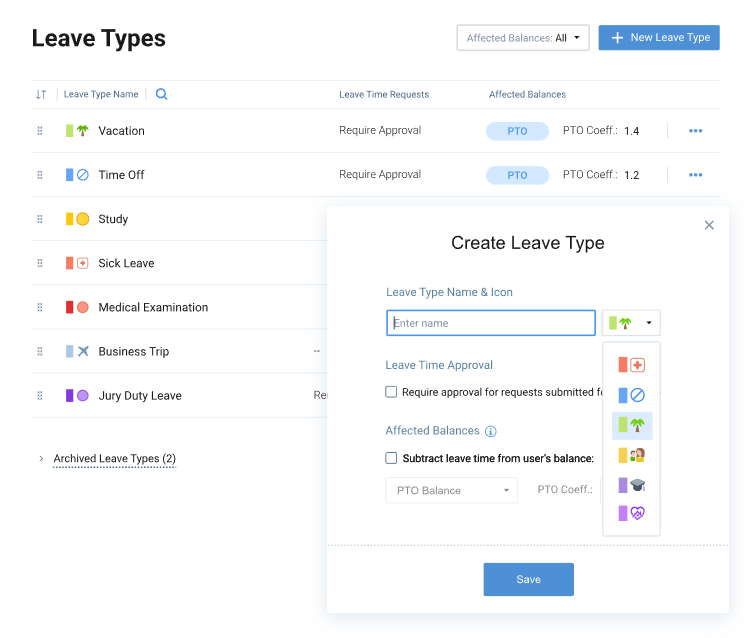
Create and manage numerous custom leave types in your actiPLANS account
Jury Duty Leave
What does this leave type mean?
This type of leave is granted to employees who are summoned for jury duty and must be present in court for the duration of the trial. The purpose of jury duty leave is to allow individuals to fulfill their civic duty in the legal system without fear of losing their jobs or suffering repercussions from their employers.
Federal requirements
According to the FLSA, employers must allow their employees to take unpaid leave for jury duty service. The law requires employers to offer their employees reasonable time off to serve on a jury and prohibits any retaliation or discrimination against employees who take such leave.
State requirements
In some states, employers are required to compensate their employees for a certain amount of lost wages while on jury duty leave. In Connecticut, for example, full-time employees receive regular wages for the first 5 days of jury duty and, after that, are paid $50 a day by the state for the rest of the service period.
Real-life application
Employers may request proof of service from employees to confirm their jury duty status and ensure that time off is used appropriately. Besides, some employers require their staff members to use the accrued PTO for jury duty (in case such a requirement doesn’t conflict with state laws).
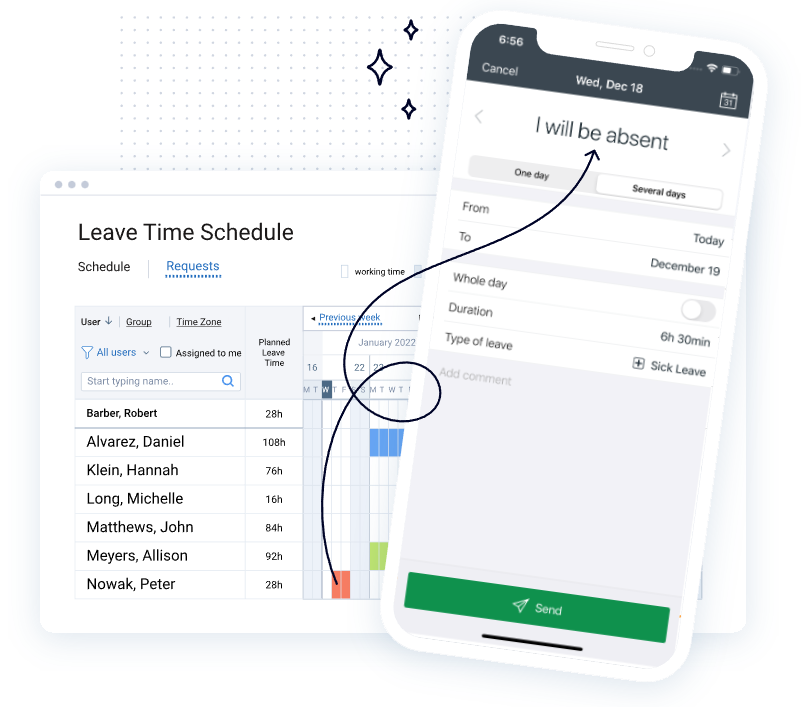
Request time off and track employee availability right on your smartphone with actiPLANS Mobile
Military Leave
What does this leave type mean?
Military leave is granted to employees who are called to active duty or reserve duty, as well as those who must attend military training or other related activities.
The leave period may vary depending on the employee’s military obligations and the specific requirements of their job – some may be provided with military leave for just a few days or weeks, while others for several months or even years.
Federal requirements
Military leave is protected under the Uniformed Services Employment and Reemployment Rights Act (USERRA), which mandates that employees are entitled to up to 5 years of unpaid military leave. Moreover, the USERRA ensures that employees who return from military leave are not discriminated against based on their military service, and are entitled to the same salary, benefits, and other employment conditions as they enjoyed before taking leave.
State requirements
In most states, employees taking military leave have the same (or similar) rights and benefits as per the USERRA.
Real-life application
According to the U.S. Bureau of Labor Statistics, around 50% of private industry employees in large organizations had access to paid military leave in 2018. In contrast, 76% of employees in state and government establishments had access to this benefit.
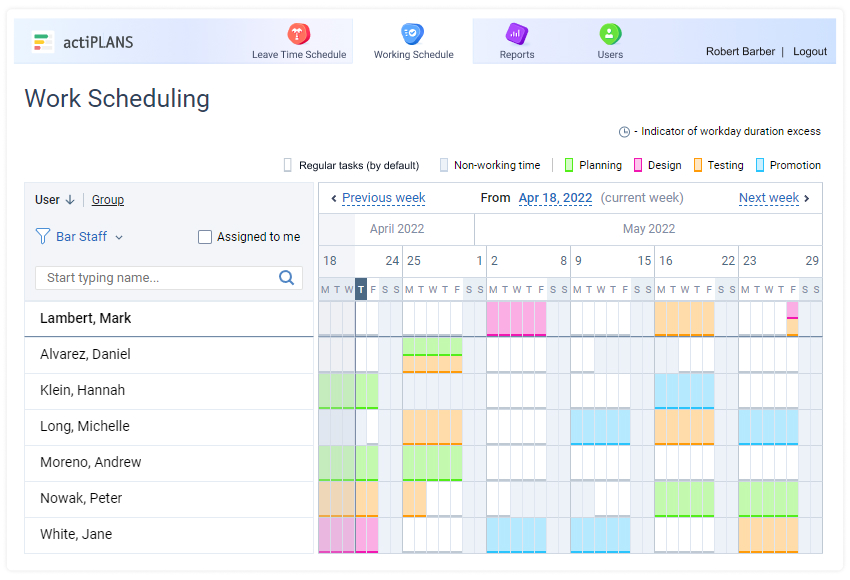
Schedule project resources and activities considering employees’ absences in actiPLANS
Voting Leave
What does this leave type mean?
The United States strives to keep elections fair and impartial and provide everyone with equal access to their voting rights. And that’s what voting leave is for – it gives employees an opportunity to exercise their right to vote without jeopardizing their employment.
Federal requirements
There is no federal law in place that mandates employers to offer paid or unpaid leave for voting purposes.
State requirements
Many states have their own laws that provide employees with time off to vote. For example, several hours of paid voting leave are secured for the workforce in Colorado, California, Iowa, and Kansas, while Georgia, Wisconsin, and Kentucky guarantee unpaid voting leave (Source).
Real-life application
Since there is no federal law on voting leave in the country and there are still some states without any voting leave policies, U.S. businesses took the initiative to protect employees’ voting rights themselves.
The Time to Vote campaign was established in an effort to encourage businesses to pledge to provide their employees with enough time to vote on election days. According to Bloomberg Law, the campaign “got 480 companies to make the pledge in 2018, the campaign’s first year. The list grew to 1,000 companies in 2020 and has surpassed 2,000 companies” in 2022.
The list of companies that made the pledge includes Google, Intel, Visa, Reddit, and many more prominent businesses.
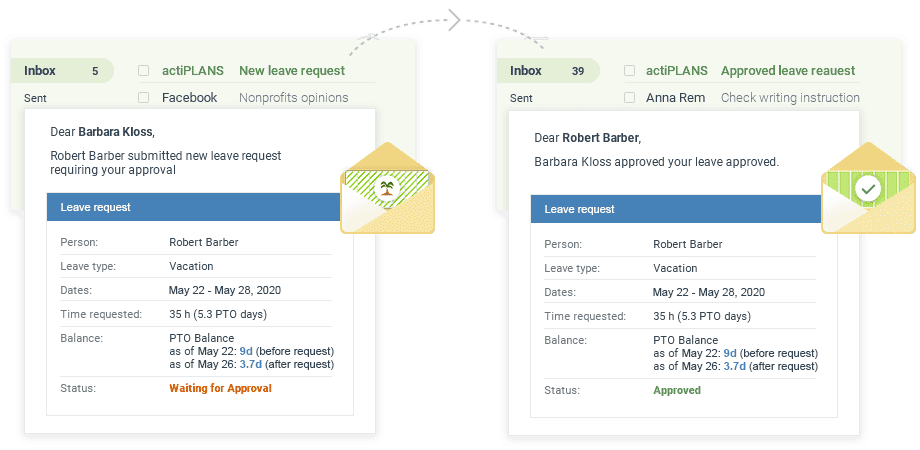
Save time on team communication thanks to automatic email notifications in actiPLANS
Leave Management Rules
Time off accrual
Time off accrual refers to a system in which employees gradually build up PTO or vacation hours. Although it is not mandated by any specific federal law or regulation, the system has proven to be an effective and beneficial approach for both employers and employees alike.
The primary purpose of time off accrual is to track and manage the amount of PTO that employees earn throughout the year, which is typically based on the length of their employment and their job position. This enables employers to accurately calculate and manage their employees’ vacation and personal leave days, as well as any sick leave or other paid time off that they may be eligible for.
Find out more about the most common PTO accrual practices here. 👈
Carryover rules
Time off carryover is a benefit that many employers offer to their employees, allowing them to carry over a certain amount of unused vacation or personal time off from one year to the next. This means that if an employee does not use all of their allotted vacation time or personal days in a given year, that time can be carried over and used at a later date.
The opposite of time off carryover is the use-it-or-lose-it policy, which imposes a deadline on when an employee must use their allotted time off, or else they will forfeit it.
The U.S. federal laws do not cover time off carryover rules, yet many states have their own regulations in this regard. For example, the use-it-or-lose-it policy is forbidden in:
- Montana
- Colorado
- California
- Nebraska
Find out how to create your own PTO policy here. 👈
Compensation for unused vacation days
PTO payout is a compensation package, which refers to the monetary value of accrued vacation and sick leave hours that can be converted into cash when unused. This payout can be given to employees either upon their resignation or at the end of the company’s fiscal year.
Currently, no federal law guarantees PTO payouts to employees. However, some states require it. For example, accrued PTO is regarded as a form of wage in Indiana, Colorado, and Louisiana. Hence, employers from these states are obliged to compensate their employees for unused PTO days upon resignation.
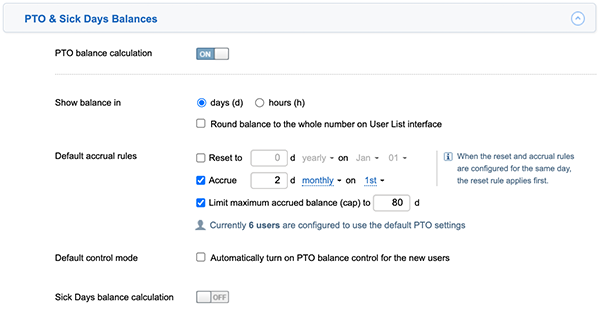
Fine-tune your PTO accrual rules using actiPLANS flexible settings to align them with relevant leave regulations and policies
Conclusion
The United States leave laws vary a great deal between states, and it’s vital to take the necessary measures to ensure your business is not only compliant with existing regulations but also prepared for any updates that may come your way.
Make sure to update your organizational time off policies in accordance with all the applicable leave management rules and paid holidays by law. And to simplify employee leave tracking, consider adopting actiPLANS.
This intuitive resource scheduling solution has all the features you need to make leave management a breeze. It lets you:
- Create multiple bespoke leave types,
- Schedule time off in just a few clicks,
- Automate leave request approval,
- Customize your PTO accrual and carryover rules,
- Analyze time off data in detailed reports and more.
Sign up for a free 30-day trial now and let actiPLANS be your key to success when managing employee absences in line with the law.



